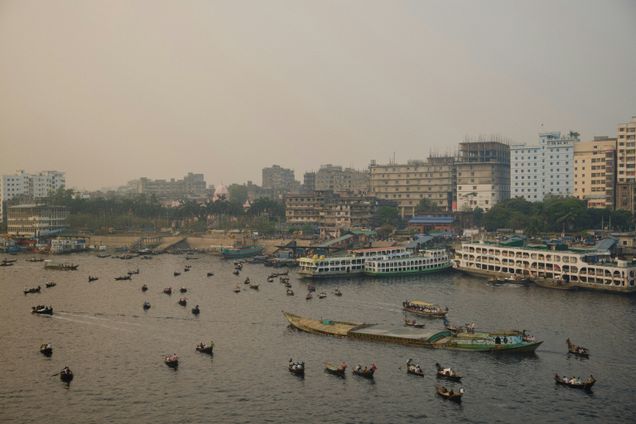Seminar Summary — Reducing Emissions and Air Pollution from the Informal Sector: Evidence from Bangladesh

On October 23, 2024, the Human Capital Initiative (HCI) hosted Nina Brooks, Core Faculty Member of HCI at the Boston University Global Development Policy Center and Assistant Professor of Global Health with the Boston University School of Public Health, as part of the 2024 Fall HCI Research Seminar Series, to present her study “Reducing Emissions and Air Pollution from the Informal Sector: Evidence from Bangladesh.” Brooks and coauthors examine the intersection of climate change, air pollution and economic development in Bangladesh through a randomized control trial to introduce improved operational practices for brick kilns.
Air pollution is the fourth leading risk factor for early death in the world, with a disproportionate amount of this burden falling on South Asia. One of the largest sources of air pollution and greenhouse gas emissions in this region is brick manufacturing, which produces particularly dangerous Particulate Matter (PM) 2.5 that can directly enter the bloodstream. While these informal brick kilns are producing vital construction materials for Bangladesh’s economic development, they are also greatly impacting local air quality. As the construction sector accounts for 10 percent of the country’s gross domestic product (GDP), the authors aimed to address two research questions: Will informal kiln owners adopt improved operational practices? And: Will improved operational practices reduce greenhouse gas and PM 2.5 emissions from informal brick manufacturing in Bangladesh?
To investigate these questions, the authors implemented an intervention with multiple components: informing kiln owners about better manufacturing practices to increase brick quality while reducing emissions and improving efficiency, providing training to correct operations, and offering technical support both through in-person visits and remotely throughout the 2022-2023 firing season. They also had an incentive arm of their trial, where these technical interventions were paired with messaging about the business rationale for incentivizing workers and suggestions for both financial and non-financial incentives that would encourage workers to adopt these operational changes. Brooks detailed how they measured their outcomes through a few different streams: they tracked the adoption of fuel feeding and stacking practices, fuel use, energy use and emissions from the kilns, economic benefits for the kiln owners and worker conditions.
Though the government has tried to impose regulations ranging from limiting the permitted locations of kilns and PM standards to mandating environmental clearances, none have been meaningfully enforceable. The study finds that more than 60 percent of kilns adopted the improved practices leading to significant reductions in CO2 and PM2.5 emissions. The authors estimate that if all informal zigzag kilns in Bangladesh were to adopt these practices, it would result in a 2,400-kiloton reduction in CO2 emissions per firing season (or 2 percent of Bangladesh’s total annual CO2 emissions). This shows that technical interventions are a highly promising method for improving both climate and health outcomes through cleaner brick production. However, the incentive arm of the trial had no effect on the usage of incentives or benefits for workers, though notably also did not worsen conditions, which points to larger issues of labor safety and workers’ rights. Many of the workers in the kilns are exploited, and working conditions are extremely dangerous.
Participants had questions regarding different aspects of the intervention, including effectiveness measures, health externalities and implications for workers. One participant was curious about how the authors had developed this intervention and had known that the brick kiln changes would be environmentally beneficial. Brooks answered that their partners in India had noticed these techniques being used with kilns, and that they refined their intervention approach from these observations. Another participant wanted to clarify whether a worker’s payment was tied to the output of bricks or hours worked, to which Brooks responded that while typically the compensation is tied to brick output, but workers may not necessarily be allowed to finish early if their output was more efficient, even if they wanted to. A significant theme throughout the questions was the workers’ health and rights, such as one question raised about the health impacts of standing on or near the hot kilns when working with bricks. Brooks responded that this intervention did not include any health measures for the workers, however, occupational heat stress is incredibly important to understand, and this is an avenue the authors are interested in exploring for upcoming projects.
Regarding future work, Brooks discussed plans to expand the intervention to other sites within Bangladesh and include more testing mechanisms to understand spillover effects of the improved kilns. The authors hope to develop even more robust interventions that would address the abysmal working conditions in the kilns and are also in the process of building partnerships to scale their intervention regionally across South Asia. Brooks’ work will inform best practices for brick-firing to improve outcomes for both local communities and the environment at large.
*
Never miss an update: Subscribe to the Human Capital Initiative newsletter.